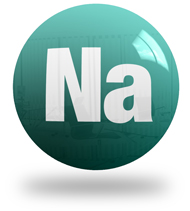
Sources Of Sodium
| Seafood - | tuna, clams, caviar, lobster, sardines, scallops, shrimp | |
| Meats - | brains, eggs, beef kidneys, beef liver | |
| Vegetables - | beet greens, celery, Swiss chard, olives, peas | |
| Dairy - | butter, buttermilk, cheeses | |
| Miscellaneous - | pickles, table salt, soy sauce, steak sauce, kelp, brewer's yeast, drinking water from water softeners. Processed and fast foods are often high in salt content | |
Roles In The Body
Sodium is an extracellular element, involved in fluid balance, regulation of blood pressure and cell membrane permeability.
Functions Of Sodium
| Circulatory - | maintenance of blood pressure, increases heart rate | |
| Excretory - | helps maintain acid-base balance | |
| Digestive - | required to produce hydrochloric acid in the stomach | |
| Endocrine - | reduces aldosterone secretion | |
| Detoxification - | keeps toxic substances in solution | |
Synergistic Nutrients
| Absorption - | glucose | |
| Metabolic - | manganese, chromium, vitamin C, E and B complex | |
Antagonistic Nutrients
| Absorption - | calcium | |
| Metabolic - | zinc, choline, inositol | |
Hair Analysis Notes
Sodium is referred to as the volatility mineral
High Hair Sodium:
- indicative of excessive adrenal gland activity
- often indicates excitability and fast oxidation
- sodium levels can be elevated by toxic metals, especially cadmium
Low Hair Sodium:
- excellent indicator of impaired adrenal gland activity
- very low sodium is indicative of exhaustion
- hair must not be washed at the laboratory for accurate readings
Supplementing Sodium
Salt consumption can be harmful if excessive, or if blood pressure is elevated. Slow oxidizers with low sodium levels and low blood pressure often feel better when they use sea salt or soy sauce in cooking.
This material is for educational purposes only
The preceding statements have not been evaluated by the
Food and Drug Administration
This information is not intended to diagnose, treat, cure or prevent any disease.
The preceding statements have not been evaluated by the
Food and Drug Administration
This information is not intended to diagnose, treat, cure or prevent any disease.
Copyright © 2012 -2020
